A Review of Nanofluids as Coolants for Thermal Management Systems in Fuel Cell Vehicles
Abstract
:1. Introduction
1.1. Nanofluid Overview
1.2. Nanofluid Application in Different Types of Vehicles
1.2.1. Nanofluid Application in Oil-Fueled Vehicles
- Nanofluid application in oil-fueled vehicles’ cooling systems
- Nanofluid applications in oil-fueled vehicles’ air conditioner systems
- Nanofluid applications in oil-fueled vehicles’ lubrication systems
- Nanofluid applications in oil-fueled vehicles’ exhaust power generation systems
1.2.2. Nanofluid Application in Electric Vehicles
1.2.3. Nanofluid Application in Fuel Cell Vehicles
2. Nanofluid Application in Thermal Management Systems of Fuel Cell Vehicles
2.1. Thermal Management System Structure
2.2. Cooling Performance Improvement of Thermal Management System
2.2.1. Heat-Production Components
- Cooling techniques for fuel cells
- Cooling techniques for batteries
- Cooling techniques for other components
2.2.2. Heat-Dissipation Components
3. Nanofluids as Coolants in Fuel Cell Vehicles
3.1. Nanofluid Thermophysical Properties
3.2. Nanofluid Thermal Conductivity Model
3.3. Single and Hybrid Nanofluids
4. The Challenges of Nanofluid Application in Fuel Cell Vehicles
4.1. Nanofluid Stability and Cleaning
- Nanofluid stability
- Nanofluid cleaning
4.2. Nanofluids in the Cooling Process
4.2.1. Nanofluid Erosion and Abrasion of the Microchannel Surface
4.2.2. Pump Transport Power
4.2.3. Nanofluid Electrical Conductivity
5. Research Directions for Nanofluids in the Future
5.1. Nanofluid Stability Improvement
5.2. Hybrid Nanofluid Application
5.3. Reduction in Erosion and Abrasion by Nanofluids
5.4. Thermal Conductivity Model of Nanofluids
5.5. Electrical Conductivity of Nanofluids
6. Conclusions
Author Contributions
Funding
Data Availability Statement
Conflicts of Interest
Nomenclature
| Al2O3 | Aluminum oxide |
| AgO | Silver oxide |
| ACS | Air conditioner System |
| Ag | Argentum |
| Al | Aluminum |
| AAC | Automotive air conditioning |
| AVL | Automatic vehicle location |
| BG | Butylene glycol |
| BN | Boron nitride |
| BTM | Battery thermal management |
| CATB | Cetyltriethylammonium bromide |
| Cu | Cuprum |
| CuO | Copper oxide |
| CFD | Computational fluid dynamics |
| CNC | Cellulose nanocrystal |
| CNT | Carbon nanotubes |
| COP | Coefficient of performance |
| CQD | Carbon quantum dot |
| CLPHP | Closed-loop pulsating heat pipe |
| DC/DC | Direct current to direct current converter |
| DLVO | Derjaguin Landau Vewey Overbeek |
| DTG | Thermogravimetric analysis |
| DSC | Differential scanning calorimetry |
| EG | Ethylene glycol |
| Fe2O3 | Ferric oxide |
| Fe3O4 | Ferric oxide |
| GnP | Graphene nanoplatelet |
| HfO2 | Hafnium oxide |
| JHGO | Janus graphene nanofluid |
| LB | Lattice Boltzmann |
| LPM | Liter per minute |
| MD | Molecular dynamics |
| MWCNT | Multiwalled carbon nanotube |
| MgO | Manganese oxide |
| NaCl | Sodium chloride |
| OHTC | Overall heat transfer coefficient |
| PAG | Polyalkylene glycol |
| PVP | Polyvinyl pyrrolidone |
| P-G-O | Polyoxyethylated graphene oxide |
| PEMFC | Proton-exchange membrane fuel cell |
| SiC | Silicon carbide |
| SDS | Sodium dodecyl sulfate |
| SDBS | Sodium dodecyl benzene sulfonate |
| SiO2 | Silicon dioxide |
| SWCNT | Single-walled carbon nanotube |
| TiO2 | Titanium oxide |
| TEG | Thermoelectric generator |
| TEC | Thermoelectrical conductivity |
| TGA | Thermogravimetric analysis |
| U.S. | United States |
| WEG | Water ethylene glycol |
| Zn | Zinc |
| ZnO | Zinc oxide |
| Symbols: | |
| Ap | Constant |
| Ai | Heat exchange area inside flat tube |
| A0 | Heat exchange area outside flat tube |
| Bp | Constant |
| Cnf | Nanofluid specific heat |
| Cbf | Base fluid specific heat |
| Cp | Nanoparticle specific heat |
| d | Nanoparticle diameter |
| hi | Convective heat transfer coefficient inside flat tube |
| h0 | Convective heat transfer coefficient outside flat tube |
| knf | Nanofluid thermal conductivity |
| kbf | Base fluid thermal conductivity |
| kp | Nanoparticle thermal conductivity |
| K | Convective heat transfer coefficient |
| kl | Average thermal conductivity of nanofluid adsorption layer |
| kl(r) | Thermal conductivity within the adsorption layer |
| L | Nanoparticle length |
| n | Shape factor |
| p | Constant |
| Ri | Fouling resistance inside flat tube |
| R0 | Fouling resistance outside flat tube |
| rp | Nanoparticle size |
| t | Adsorption layer thickness |
| α | Constant |
| Thickness of flat tube | |
| Flat tube thermal conductivity | |
| Nanofluid density | |
| Base fluid density | |
| Nanoparticle density | |
| Nanofluid volume fraction | |
| Sphericity degree |
References
- Choi, S.U.S. A new field of scientific research and innovative applications. Heat Transf. Eng. 2008, 29, 429–431. [Google Scholar] [CrossRef]
- Frank, M.; Papanikoulaou, M.; Drikakis, D.; Salonitis, K. Heat transfer across a fractal surface. J. Chem. Phys. 2019, 151, 134705. [Google Scholar] [CrossRef] [PubMed]
- Frank, M.; Drikakis, D. Solid-like heat transfer in confined liquids. Microfluid. Nanofluidics 2017, 21, 148. [Google Scholar] [CrossRef]
- Ghorbanian, J.; Beskok, A. Scale effects in nano-channel liquid flows. Microfluid. Nanofluidics 2016, 20, 121. [Google Scholar] [CrossRef]
- Papanikolaou, M.; Frank, M.; Drikakis, D. Nanoflow over a fractal structure. Phys. Fluids 2016, 28, 082001. [Google Scholar] [CrossRef]
- Liu, Y.C.; Wang, Q.; Li, Z.; Tao, W. Dynamics and density profile of water in nanotubes as one-dimensional fluid. Langmuir 2005, 21, 12025–12030. [Google Scholar] [CrossRef] [PubMed]
- McGaughey, A.J.H.; Kaviany, M. Thermal conductivity decomposition and analysis using molecular dynamics simulations Part II. Complex silica structures. Int. J. Heat Mass Transf. 2004, 47, 1799–1816. [Google Scholar] [CrossRef]
- Sun, G.X.; Bonaccurso, E.; Franz, V.; Butt, H.J. Confined liquid: Simultaneous observation of a molecularly layered structure and hydrodynamic slip. J. Chem. Phys. 2002, 117, 10311. [Google Scholar] [CrossRef]
- Jafari, S.M.; Jabari, S.S.; Dehnad, D.; Shahidi, S.A. Heat transfer enhancement in thermal processing of tomato juice by application of nanofluids. Food Bioprocess Technol. 2017, 10, 307–316. [Google Scholar] [CrossRef]
- Jafari, S.M.; Saramnejad, F.; Dehnad, D. Designing and application of a shell and tube heat exchanger for nanofluid thermal processing of liquid food products. J. Food Process Eng. 2018, 41, e12658. [Google Scholar] [CrossRef]
- Jafari, S.M.; Jabari, S.S.; Dehnad, D.; Shahidi, S.A. Effects of thermal processing by nanofluids on Vitamin C, total phenolics and total soluble solids of tomato juice. J. Food Sci. Technol.-Mysore 2017, 54, 679–686. [Google Scholar] [CrossRef] [PubMed]
- Salari, S.; Jafari, S.M. Application of nanofluids for thermal processing of food products. Trends Food Sci. Technol. 2020, 97, 100–113. [Google Scholar] [CrossRef]
- Tarafdar, P.; Sirohi, R.; Negi, T.; Singh, S.; Badgujar, P.C.; Shahi, N.C.; Kumar, S.; Sim, S.J.; Pandey, A. Nanofluid research advances: Preparation, characteristics, and applications in food processing. Food Res. Int. 2021, 150, 110751. [Google Scholar] [CrossRef] [PubMed]
- Zhao, M.N.; Yang, X.Y.; Feng, J.; Li, Y.; Dong, H.L.; Ren, J.; Xia, X.F. Research progress on the application of nanofluid in liquid food sterilization and its action mechanism. Sci. Technol. Food Ind. 2022, 43, 481–487. [Google Scholar]
- Xiong, Q.G.; Altnji, S.; Tayebi, T.; Izadi, M.; Hajjar, A.; Sunden, B.; Li, L.K.B. A comprehensive review on the application of hybrid nanofluids in solar energy collectors. Sustain. Energy Technol. Assess. 2021, 47, 101341. [Google Scholar] [CrossRef]
- Khanafer, K.; Vafai, K. A review on the applications of nanofluids in solar energy field. Renew. Energy 2018, 123, 398–406. [Google Scholar] [CrossRef]
- Panduro, E.A.C.; Finotti, F.; Largiller, G.; Lervag, K.Y. A review of the use of nanofluids as heat-transfer fluids in parabolic-trough collectors. Appl. Therm. Eng. 2022, 211, 118346. [Google Scholar] [CrossRef]
- Cui, F.Y.; Liu, F.H.; Tong, Y.J.; Wang, S.F.; Guo, W.G.; Han, T.L. Energy and exergy assessment of evacuated tube solar collector using water, Fe3O4 nanofluid and Fe3O4/MWCNT hybrid nanofluid. Process Saf. Environ. Prot. 2023, 163, 236–243. [Google Scholar] [CrossRef]
- Tong, Y.J.; Lee, H.; Kang, W.; Cho, H.H. Energy and exergy comparison of a flat-plate solar collector using water, Al2O3 nanofluid, and CuO nanofluid. Appl. Therm. Eng. 2019, 159, 113959. [Google Scholar] [CrossRef]
- Tong, Y.J.; Chi, X.N.; Kang, W.; Cho, H.H. Comparative investigation of efficiency sensitivity in a flat plate solar collector according to nanofluids. Appl. Therm. Eng. 2020, 174, 115346. [Google Scholar] [CrossRef]
- Hamzat, A.K.; Omisanya, M.I.; Sahin, A.Z.; Oyetunji, O.R.; Olaitan, N.A. Application of nanofluid in solar energy harvesting devices: A comprehensive review. Energy Convers. Manag. 2022, 266, 115790. [Google Scholar] [CrossRef]
- Sattar, A.; Farooq, M.; Amjad, M.; Saeed, M.A.; Nawaz, S.; Mujtaba, M.A.; Mujtaba, S.; El-Sherbeeny, A.M.; Soudagar, M.E.M.; Filho, E.P.B.; et al. Performance evaluation of a direct absorption collector for solar thermal energy conversion. Energies 2020, 13, 4956. [Google Scholar] [CrossRef]
- Chinchole, A.S.; Dasgupta, A.; Kulkarni, P.P.; Chandraker, D.K.; Nayak, A.K. Exploring the use of alumina nanofluid as emergency coolant for nuclear fuel bundle. J. Therm. Sci. Eng. Appl. 2019, 11, 021007. [Google Scholar] [CrossRef]
- Rahnama, Z.; Ansarifar, G.R. Predicting and optimizing the thermal-hydraulic, natural circulation, and neutronics parameters in the NuScale nuclear reactor using nanofluid as a coolant via machine learning methods through GA, PSO and HPSOGA algorithms. Ann. Nucl. Energy 2021, 161, 108375. [Google Scholar] [CrossRef]
- Kouloulias, K.; Sergis, A.; Hardalupas, Y.; Barrett, T.R. Visualisation of subcooled pool boiling in nanofluids. Fusion Eng. Des. 2019, 146, 153–156. [Google Scholar] [CrossRef]
- Hadad, K.; Kowsar, Z. Twofold application of nanofluids as the primary coolant and reactivity controller in a PWR reactor: Case study VVER-1000 in normal operation. Ann. Nucl. Energy 2016, 97, 179–182. [Google Scholar] [CrossRef]
- Kang, M.; Jee, C.; Park, S.; Bang, I.C.; Heo, G. Design process of the nanofluid injection mechanism in nuclear power plants. Nanoscale Res. Lett. 2011, 6, 363. [Google Scholar] [CrossRef]
- Ghorbanali, Z.; Talebi, S. Investigation of a nanofluid-based natural circulation loop. Prog. Nucl. Energy 2020, 129, 103494. [Google Scholar] [CrossRef]
- Ghazanfari, R.; Talebi, M.; Khorsandi, J.; Abdolahi, R. Effects of water based Al2O3, TiO2, and CuO nanofluids as the coolant on solid and annular fuels for a typical VVER-1000 core. Prog. Nucl. Energy 2016, 91, 285–294. [Google Scholar] [CrossRef]
- Bafrani, H.A.; Noori-kalkhoran, O.; Gei, M.; Ahangari, R.; Mirzaee, M.M. On the use of boundary conditions and thermophysical properties of nanoparticles for application of nanofluids as coolant in nuclear power plants; a numerical study. Prog. Nucl. Energy 2020, 126, 103417. [Google Scholar] [CrossRef]
- Khuwaileh, B.A.; Al-Hamadi, F.I.; Hartanto, D.; Said, Z.; Ali, M. On the performance of nanofluids in APR 1400 PLUS7 assembly: Neutronics. Ann. Nucl. Energy 2020, 144, 107508. [Google Scholar] [CrossRef]
- Nematolahi, M.; Behzadinejad, B.; Golestani, A. Feasibility study of using nanofluids as a neutron absorber in reactor emergency core cooling system. Int. J. Hydrogen Energy 2015, 40, 15192–15197. [Google Scholar] [CrossRef]
- Bang, I.A.; Kim, J.H.F. Thermal-fluid characterizations of ZnO and SiC nanofluids for advanced nuclear power plants. Nucl. Technol. 2017, 170, 16–27. [Google Scholar] [CrossRef]
- Saadati, H.; Hadad, K.A.; Rabiee, A. Safety margin and fuel cycle period enhancements of VVER-1000 nuclear reactor using water/silver nanofluid. Nucl. Eng. Technol. 2018, 50, 639–647. [Google Scholar] [CrossRef]
- Wang, Y.; Wu, J.A. Single bubble dynamic behavior in Al2O3/H2O nanofluid on downward-facing heating surface. Nucl. Eng. Technol. 2016, 48, 915–924. [Google Scholar] [CrossRef]
- El-Masry, J.F.; Bou-Hamdan, K.F.; Abbas, A.H.; Martyushev, D.A. A comprehensive review on utilizing nanomaterials in enhanced oil recovery applications. Energies 2023, 16, 691. [Google Scholar] [CrossRef]
- Zhao, M.W.; Lv, W.J.; Li, Y.Y.; Dai, C.L.; Wang, X.K.; Zhou, H.D.; Zou, C.W.; Gao, M.W.; Zhang, Y.; Wu, Y.N. Study on the synergy between silica nanoparticles and surfactants for enhanced oil recovery during spontaneous imbibition. J. Mol. Liq. 2018, 261, 373–378. [Google Scholar] [CrossRef]
- Zhao, M.W.; Song, X.G.; Lv, W.J.; Wu, Y.N.; Dai, C.L. The preparation and spontaneous imbibition of carbon-based nanofluid for enhanced oil recovery in tight reservoirs. J. Mol. Liq. 2020, 313, 113564. [Google Scholar] [CrossRef]
- Cao, J.; Chen, Y.P.; Zhang, J.; Wang, X.J.; Wang, J.; Shi, C.X.; Ning, Y.F.; Wang, X.M. Preparation and application of nanofluid flooding based on polyoxyethylated graphene oxide nanosheets for enhanced oil recovery. Chem. Eng. Sci. 2021, 247, 117023. [Google Scholar] [CrossRef]
- Cao, J.; Chen, Y.P.; Xu, G.R.; Wang, X.L.; Li, Y.; Zhao, S.; Liu, C.L.; Wang, X.M. Study on interface regulation effects of Janus nanofluid for enhanced oil recovery. Colloids Surf. A Physicochem. Eng. Asp. 2022, 653, 129880. [Google Scholar] [CrossRef]
- Alsedrani, M.Q.; Chala, G.T. Investigation of the effects of silica nanofluid for enhanced oil recovery applications: CFD Simulation Study. Arab. J. Sci. Eng. 2022, 48, 9139–9158. [Google Scholar] [CrossRef]
- Liu, R.; Lu, J.Y.; Pu, W.F.; Xie, Q.; Lu, Y.Y.; Du, D.J.; Yang, X.R. Synergetic effect between in-situ mobility control and micro-displacement for chemical enhanced oil recovery (CEOR) of a surface-active nanofluid. J. Pet. Sci. Eng. 2021, 205, 108983. [Google Scholar] [CrossRef]
- Maaref, S.; Kantzas, A.; Bryant, S.L. The effect of water alternating solvent based nanofluid flooding on heavy oil recovery in oil-wet porous media. Fuel 2020, 282, 118808. [Google Scholar] [CrossRef]
- Soleimani, H.; Baig, M.K.; Yahya, N.; Khodapanah, L.; Sabet, M.; Demiral, B.M.R.; Burda, M. Impact of carbon nanotubes based nanofluid on oil recovery efficiency using core flooding. Results Phys. 2018, 9, 39–48. [Google Scholar] [CrossRef]
- Amani, H. Synergistic effect of biosurfactant and nanoparticle mixture on microbial enhanced oil recovery. J. Surfactants Deterg. 2017, 20, 589–597. [Google Scholar] [CrossRef]
- Kumar, R.S.; Ganat, T.A.; Sharma, T. Performance evaluation of silica nanofluid for sand column transport with simultaneous wettability alteration: An approach to environmental issue. J. Clean. Prod. 2021, 303, 127047. [Google Scholar] [CrossRef]
- Jafarbeigi, E.; Kamari, E.; Salimi, F.; Mohammadidoust, A. Experimental study of the effects of a novel nanoparticle on enhanced oil recovery in carbonate porous media. J. Pet. Sci. Eng. 2021, 195, 107602. [Google Scholar] [CrossRef]
- Cao, J.; Chen, Y.P.; Wang, X.J.; Zhang, J.; Li, Y.; Hua, Z.; Wang, X.M.; Zhao, S. Low-salinity nanofluid–A smart fluid enhanced oil recovery method. Colloids Surf. A Physicochem. Eng. Asp. 2022, 648, 129204. [Google Scholar] [CrossRef]
- Bai, Y.; Pu, C.S.; Li, X.; Huang, F.F.; Liu, S.; Liang, L.; Liu, J. Performance evaluation and mechanism study of a functionalized silica nanofluid for enhanced oil recovery in carbonate reservoirs. Colloids Surf. A Physicochem. Eng. Asp. 2022, 652, 129939. [Google Scholar] [CrossRef]
- Alomair, O.A.; Alajmi, A.F. A novel experimental nanofluid-assisted steam flooding (NASF) approach for enhanced heavy oil recovery. Fuels 2022, 313, 122691. [Google Scholar] [CrossRef]
- Al-Yaari, A.; Ching, D.L.C.; Sakidin, H.; Muthuvalu, M.S.; Zafar, M.; Alyousifi, Y.; Saeed, A.A.H.; Bilad, M.R. Thermophysical properties of nanofluid in two-phase fluid flow through a porous rectangular medium for enhanced oil recovery. Nanomaterials 2022, 12, 1011. [Google Scholar] [CrossRef]
- Mock, J. Fuel Cell Coolant Optimization and Scale Up; Dynalene Inc.: Whitehall, PA, USA, 2011. [Google Scholar]
- Yaw, C.T.; Koh, S.P.; Sandhya, M.; Kadirgama, K.; Tiong, S.K.; Ramasamy, D.; Sudhakar, K.; Samykano, M.; Benedict, F.; Tan, C.H. Heat transfer enhancement by hybrid nano additives-graphene nanoplate-lets/cellulose nanocrystal for the automobile cooling system (Radiator). Nanomaterials 2023, 13, 808. [Google Scholar] [CrossRef] [PubMed]
- Ahmed, S.A.; Ozkaymak, M.; Sözen, A.; Menlik, T.; Fahed, A. Improving car radiator performance by using TiO2-water nanofluid. Eng. Sci. Technol. Int. J. 2018, 21, 996–1005. [Google Scholar] [CrossRef]
- Elibol, E.A.; Turgut, O.; Aktas, F.; Senol, H.; Celik, A.F. Experimental investigation on heat transfer and flow characteristics of TiO2-water nanofluid in a heavy vehicle radiator. J. Therm. Anal. Calorim. 2023, 148, 977–994. [Google Scholar] [CrossRef]
- Said, Z.; Assad, M.E.H.; Hachicha, A.A.; Bellos, E.; Abdelkareem, M.A.; Alazaizeh, D.Z.; Yousef, B.A.A. Enhancing the performance of automotive radiators using nanofluids. Renew. Sustain. Energy Rev. 2019, 112, 183–194. [Google Scholar] [CrossRef]
- Elibol, E.A.; Turgut, O. Heat transfer and fluid flow characteristics in a long offset strip fin channel by using TiO2-Water nanofluid. Arab. J. Sci. Eng. 2022, 47, 15415–15428. [Google Scholar] [CrossRef]
- Palaniappan, B.; Ramasamy, V. Thermodynamic analysis of fly ash nanofluid for automobile (heavy vehicle) radiators. J. Therm. Anal. Calorim. 2019, 136, 223–233. [Google Scholar] [CrossRef]
- Yasuri, A.K.; Soleimani, E. An experimental study on the simultaneous effect of nanofluid and tube insert on the thermal performance of an automobile cooling system. J. Appl. Fluid Mech. 2021, 14, 1559–1566. [Google Scholar]
- Sandhya, D.; Reddy, M.C.S.; Rao, V.V. Improving the cooling performance of automobile radiator with ethylene glycol water based TiO2 nanofluids. Int. Commun. Heat Mass Transf. 2016, 78, 121–126. [Google Scholar]
- Ali, M.; El-Leathy, A.M.; Al-Sofyany, Z. The effect of nanofluid concentration on the cooling system of vehicles radiator. Adv. Mech. Eng. 2014, 6, 962510. [Google Scholar] [CrossRef]
- Sokhal, G.S.; Gangacharyulu, D.; Bulasara, V.K. Influence of copper oxide nanoparticles on the thermophysical properties and performance of flat tube of vehicle cooling system. Vacuum 2018, 157, 268–276. [Google Scholar] [CrossRef]
- Kumar, V.; Sahoo, R.R. Exergy and energy performance for wavy fin radiator with a new coolant of various shape nanoparticle-based hybrid nanofluids. J. Therm. Anal. Calorim. 2020, 143, 3911–3922. [Google Scholar] [CrossRef]
- Goudarzi, K.; Jamali, H. Heat transfer enhancement of Al2O3-EG nanofluid in a car radiator with wire coil inserts. Appl. Therm. Eng. 2017, 118, 510–517. [Google Scholar] [CrossRef]
- Sheikhzadeh, G.A.; Fakhari, M.M.; Khorasanizadeh, H. Experimental investigation of laminar convection heat transfer of Al2O3-ethylene glycol-water nanofluid as a coolant in a car radiator. J. Appl. Fluid Mech. 2017, 10, 209–219. [Google Scholar] [CrossRef]
- Hussein, A.M.; Baker, R.A.; Kadirgama, K.; Sharma, K.V. Heat transfer enhancement using nanofluids in an automotive cooling system. Int. Commun. Heat Mass Transf. 2014, 53, 195–202. [Google Scholar] [CrossRef]
- Heris, S.Z.; Shokrgozar, S.; Poorpharhang, S.; Shanbedi, M.; Noie, S.H. Experimental study of heat transfer of a car radiator with CuO/ethylene glycol-water as a coolant. J. Dispers. Sci. Technol. 2014, 35, 677–684. [Google Scholar] [CrossRef]
- Kumar, A.; Chand, P.; Hassan, M.A. Louvered finned car radiator with MWCNT-SiO2 hybrid nanofluid: An experimental approach. Powder Technol. 2023, 415, 118176. [Google Scholar] [CrossRef]
- Naraki, M.; Peyghambarzadeh, S.M.; Hashemabadi, S.H.; Vermahmoudi, Y. Parametric study of overall heat transfer coefficient of CuO/water nanofluids in a car radiator. Int. J. Therm. Sci. 2013, 66, 82–90. [Google Scholar] [CrossRef]
- Seraj, M.; Yahya, S.M.; Badruddin, I.A.; Anqi, A.E.; Asjad, M.; Khan, Z.A. Multi-response optimization of nanofluid-based I. C. engine cooling system using fuzzy PIV method. Processes 2020, 8, 30. [Google Scholar] [CrossRef]
- Sonage, B.K.; Mohanan, P. Miniaturization of automobile radiator by using zinc-water and zinc oxide-water nanofluids. J. Mech. Sci. Technol. 2021, 29, 2177–2185. [Google Scholar] [CrossRef]
- Sahoo, R.R. Effect of various shape and nanoparticle concentration based ternary hybrid nanofluid coolant on the thermal performance for automotive radiator. Heat Mass Transf. 2021, 57, 873–887. [Google Scholar] [CrossRef]
- Sahoo, R.R. Thermo-hydraulic characteristics of radiator with various shape nanoparticle-based ternary hybrid nanofluid. Powder Technol. 2020, 370, 18–28. [Google Scholar] [CrossRef]
- Vajjha, R.S.; Das, D.K.; Namburu, P.K. Numerical study of fluid dynamic and heat transfer performance of Al2O3 and CuO nanofluids in the flat tubes of a radiator. Int. J. Heat Fluid Flow 2010, 31, 613–621. [Google Scholar] [CrossRef]
- Shankara, R.P.; Banapurmath, N.R.; D’Souza, A.; Sajjan, A.M.; Ayachit, N.H.; Khan, T.M.Y.; Badruddin, I.A.; Kamangar, S. An insight into the performance of radiator system using ethylene glycol-water based graphene oxide. Alex. Eng. J. 2022, 61, 5155–5167. [Google Scholar] [CrossRef]
- Peyghambarzadeh, S.M.; Hashemabadi, S.H.; Hoseini, S.M.; Jamnani, M.S. Experimental study of heat transfer enhancement using water/ethylene glycol based nanofluids as a new coolant for car radiators. Int. Commun. Heat Mass Transf. 2011, 38, 1283–1290. [Google Scholar] [CrossRef]
- Hussein, A.M.; Dawood, H.K.; Bakara, R.A.; Kadirgamaa, K. Numerical study on turbulent forced convective heat transfer using nanofluids TiO2 in an automotive cooling system. Case Stud. Therm. Eng. 2017, 9, 72–78. [Google Scholar] [CrossRef]
- Elsebay, M.; Elbadawy, I.; Shedid, M.H.; Fatouh, M. Numerical resizing study of Al2O3 and CuO nanofluids in the flat tubes of a radiator. Appl. Math. Model. 2016, 40, 6437–6450. [Google Scholar] [CrossRef]
- Akash, A.R.; Pattamatta, A.; Das, S.K. Experimental study of the thermohydraulic performance of water/ethylene glycol-based graphite nano-coolant in vehicle radiators. J. Enhanc. Heat Transf. 2019, 26, 345–363. [Google Scholar] [CrossRef]
- Leong, K.Y.; Saidur, R.; Kazi, S.N.; Mamun, A.H. Performance investigation of an automotive car radiator operated with nanofluid-based coolants (nanofluid as a coolant in a radiator). Appl. Therm. Eng. 2010, 30, 2685–2692. [Google Scholar] [CrossRef]
- Karagoz, Y.; Koten, H.; Tuncer, E.; Pusat, S. Effect of Al2O3 addition to an internal combustion engine coolant on heat transfer performance. Case Stud. Therm. Eng. 2022, 31, 101847. [Google Scholar] [CrossRef]
- Peyghambarzadeh, S.M.; Hashemabadi, S.H.; Jamnani, M.S.; Hoseini, S.M. Improving the cooling performance of automobile radiator with Al2O3/water nanofluid. Appl. Therm. Eng. 2011, 31, 1833–1838. [Google Scholar] [CrossRef]
- Selvam, C.; Lal, D.M.; Harish, S. Enhanced heat transfer performance of an automobile radiator with graphene-based suspensions. Appl. Therm. Eng. 2017, 123, 50–60. [Google Scholar] [CrossRef]
- Yildiz, C.; Kaptan, C.; Arci, M.; Baynal, K. Taguchi optimization of automotive radiator cooling with nanofluids. Eur. Phys. J.-Spec. Top. 2022, 231, 2801–2819. [Google Scholar] [CrossRef]
- Elias, M.M.; Mahbubul, I.M.; Saidur, R.; Sohel, M.R.; Shahrul, I.M.; Khaleduzzaman, S.S.; Sadeghipour, S. Experimental investigation on the thermo-physical properties of Al2O3 nanoparticles suspended in car radiator coolant. Int. Commun. Heat Mass Transf. 2014, 54, 48–53. [Google Scholar] [CrossRef]
- Hussein, A.M.; Bakar, R.A.; Kadirgama, K.; Sharma, K.V. Heat transfer augmentation of a car radiator using nanofluids. Heat Mass Transf. 2014, 50, 1553–1561. [Google Scholar] [CrossRef]
- Mousavi, H.; Ghomshe, S.M.T.; Rashidi, A.; Mirzaei, M. Hybrids carbon quantum dots as new nanofluids for heat transfer enhancement in wet cooling towers. Heat Mass Transf. 2021, 58, 309–320. [Google Scholar] [CrossRef]
- Shah, T.R.; Ali, H.M.; Janjua, M.M. On aqua-based Silica (SiO2–Water) nano-coolant: Convective thermal potential and experimental precision evaluation in Aluminum tube radiator. Nanomaterials 2020, 10, 1736. [Google Scholar] [CrossRef]
- Peyghambarzadeh, S.M.; Hashemabadi, S.H.; Naraki, M.; Vermahmoudi, Y. Experimental study of overall heat transfer coefficient in the application of dilute nanofluids in the car radiator. Appl. Therm. Eng. 2013, 52, 8–16. [Google Scholar] [CrossRef]
- Tafakhori, M.; Kalantari, D.; Biparva, P.; Peyghambarzadeh, S.M. Assessment of Fe3O4-water nanofluid for enhancing laminar convective heat trans-fer in a car radiator. J. Therm. Anal. Calorim. 2021, 146, 841–853. [Google Scholar] [CrossRef]
- Subhedar, D.G.; Ramani, B.M.; Gupta, A. Experimental investigation of heat transfer potential of Al2O3/Water-Mono Ethylene Glycol nanofluids as a car radiator coolant. Case Stud. Therm. Eng. 2018, 11, 26–34. [Google Scholar] [CrossRef]
- Contreras, E.M.C.; Filho, E.P.B. Heat transfer performance of an automotive radiator with MWCNT nanofluid cooling in a high operating temperature range. Appl. Therm. Eng. 2022, 207, 118149. [Google Scholar] [CrossRef]
- Khan, M.S.; Dil, T. Heat transfer enhancement of automobile radiator using H2O-CuO nanofluid. AIP Adv. 2017, 7, 045018. [Google Scholar] [CrossRef]
- Delavari, V.; Hashemabadi, S.H. CFD simulation of heat transfer enhancement Al2O3/water and Al2O3/ethylene glycol nanofluids in a car radiator. Appl. Therm. Eng. 2015, 73, 380–390. [Google Scholar] [CrossRef]
- Sahoo, R.R.; Sarkar, J. Heat transfer performance characteristics of hybrid nanofluids as coolant in louvered fin automotive radiator. Heat Mass Transf. 2017, 53, 1923–1931. [Google Scholar] [CrossRef]
- Li, X.K.; Zou, C.J.; Qi, A. Experimental study on the thermo-physical properties of car engine coolant (water/ethylene glycol mixture type) based SiC nanofluids. Int. Commun. Heat Mass Transf. 2016, 77, 159–164. [Google Scholar] [CrossRef]
- Sivalingam, V.; Kumar, P.G.; Prabakaran, R.; Sun, J.; Velraj, R.; Kim, S.C. An automotive radiator with multi-walled carbon-based nanofluids: A study on heat transfer optimization using MCDM techniques. Case Stud. Therm. Eng. 2022, 29, 101724. [Google Scholar] [CrossRef]
- Mhamed, B.; Sidik, N.A.C.; Akhbar, M.F.A.; Mamat, R.; Najafi, G. Experimental study on thermal performance of MWCNT nano-coolant in Perodua Kelisa 1000cc radiator system. Int. Commun. Heat Mass Transf. 2016, 76, 156–161. [Google Scholar] [CrossRef]
- Khan, A.; Ali, H.M.; Nazir, R.; Ali, R.; Munir, A.; Ahmad, B.; Ahmad, Z. Experimental investigation of enhanced heat transfer of a car radiator using ZnO nanoparticles in H2O–ethylene glycol mixture. J. Therm. Anal. Calorim. 2019, 138, 3007–3021. [Google Scholar] [CrossRef]
- Xian, H.W.; Sidik, N.A.C.; Najafi, G. Recent state of nanofluid in automobile cooling systems. J. Therm. Anal. Calorim. 2019, 135, 981–1008. [Google Scholar] [CrossRef]
- Arora, N.; Gupta, M. An updated review on application of nanofluids in flat tubes radiators for improving cooling performance. Renew. Sustain. Energy Rev. 2020, 134, 110242. [Google Scholar] [CrossRef]
- Sidik, N.A.C.; Yazid, M.N.A.W.M.; Mamat, R. A review on the application of nanofluids in vehicle engine cooling system. Int. Commun. Heat Mass Transf. 2015, 68, 85–90. [Google Scholar] [CrossRef]
- Sidik, N.A.C.; Yazid, M.N.A.W.M.; Mamat, R. Recent advancement of nanofluids in engine cooling system. Renew. Sustain. Energy Rev. 2017, 75, 137–144. [Google Scholar] [CrossRef]
- Abbas, F.; Ali, H.M.; Shah, T.R.; Babar, H.; Janjua, M.M.; Sajjad, U.; Amer, M. Nanofluid: Potential evaluation in automotive radiator. J. Mol. Liq. 2020, 297, 112014. [Google Scholar] [CrossRef]
- Zhao, N.B.; Li, S.Y.; Yang, J.L. A review on nanofluids: Data-driven modeling of thermophysical properties and the application in automotive radiator. Renew. Sustain. Energy Rev. 2016, 66, 596–616. [Google Scholar] [CrossRef]
- Bigdeli, M.B.; Fasano, M.; Cardellini, A.; Chiavazzo, E.; Asinari, P. A review on the heat and mass transfer phenomena in nanofluid coolants with special focus on automotive applications. Renew. Sustain. Energy Rev. 2016, 60, 1615–1633. [Google Scholar] [CrossRef]
- Almurtaji, S.; Ali, N.; Teixeira, J.A.; Addali, A. On the role of nanofluids in thermal-hydraulic performance of heat exchangers—A review. Nanomaterials 2020, 10, 734. [Google Scholar] [CrossRef] [PubMed]
- Sharif, M.Z.; Azmi, W.H.; Redhwan, A.A.M.; Mamat, R.; Yusof, T.M. Performance analysis of SiO2/PAG nano lubricant in automotive air conditioning system. Int. J. Refrig. 2017, 75, 204–216. [Google Scholar] [CrossRef]
- Redhwan, A.A.M.; Azmi, W.H.; Sharif, M.Z.; Mamat, R.; Zawawi, N.N.M. Comparative study of thermo-physical properties of SiO2 and Al2O3 nanoparticles dispersed in PAG lubricant. Appl. Therm. Eng. 2017, 116, 823–832. [Google Scholar] [CrossRef]
- Zawawi, N.N.M.; Azmi, W.H.; Ghazali, M.F. Performance of Al2O3-SiO2/PAG composite nano lubricants in automotive air-conditioning system. Appl. Therm. Eng. 2022, 204, 117998. [Google Scholar] [CrossRef]
- Ali, M.K.A.; Hou, X.J. Improving the heat transfer capability and thermal stability of vehicle engine oils using Al2O3/TiO2 nanomaterials. Powder Technol. 2020, 363, 48–58. [Google Scholar] [CrossRef]
- Lue, Y.F.; Hung, Y.H.; Li, F.S.; Teng, T.P.; Chen, S.Y.; Wu, C.H.; Ou, Y.C. Performance assessment and scooter verification of nano-Alumina engine oil. Appl. Sci. 2016, 6, 258. [Google Scholar] [CrossRef]
- Esfe, M.H.; Arani, A.A.A.; Esfandeh, S. Improving engine oil lubrication in light-duty vehicles by using of dispersing MWCNT and ZnO nanoparticles in 5W50 as viscosity index improvers (VII). Appl. Therm. Eng. 2018, 143, 493–506. [Google Scholar] [CrossRef]
- Hilmin, M.N.H.M.; Remeli, M.F.; Singh, B.; Affandi, N.D.N. Thermoelectric power generations from vehicle exhaust gas with TiO2 nanofluid cooling. Therm. Sci. Eng. Prog. 2021, 18, 100558. [Google Scholar] [CrossRef]
- Karana, D.R.; Sahoo, R.R. Effect on TEG performance for waste heat recovery of automobiles using MgO and ZnO nanofluid coolants. Case Stud. Therm. Eng. 2019, 12, 358–364. [Google Scholar] [CrossRef]
- Chen, M.; Li, J.J. Experimental study on heating performance of pure electric vehicle power battery under low temperature environment. Int. J. Heat Mass Transf. 2021, 172, 121191. [Google Scholar] [CrossRef]
- Wu, F.C.; Rao, Z.H. The lattice Boltzmann investigation of natural convection for nanofluid based battery thermal management. Appl. Therm. Eng. 2017, 115, 659–669. [Google Scholar] [CrossRef]
- Abdelkareem, M.A.; Maghrabie, H.M.; Abo-Khalil, A.G.; Adhari, O.H.K.; Sayed, E.T.; Radwan, A.; Elsaid, K.; Wilberforce, T.; Olabi, A.G. Battery thermal management systems based on nanofluids for electric vehicles. J. Energy Storage 2022, 50, 104385. [Google Scholar] [CrossRef]
- Guo, H.Z.; Li, J.; Zhu, Z.Y.; Lv, P.H. Numerical investigation on thermal performance of battery module with LCP-AFC cooling system applied in electric vehicle. Energy Sci. Eng. 2022, 10, 4431–4446. [Google Scholar] [CrossRef]
- Kiani, M.; Ansari, M.; Arshadi, A.A.; Houshfar, E.; Ashjaee, M. Hybrid thermal management of lithium-ion batteries using nanofluid, metal foam, and phase change material: An integrated numerical–experimental approach. J. Therm. Anal. Calorim. 2020, 141, 1703–1715. [Google Scholar] [CrossRef]
- Liao, G.L.; Wang, W.D.; Zhang, F.; E, J.Q.; Chen, J.W.; Leng, E.W. Thermal performance of lithium-ion battery thermal management system based on nanofluid. Appl. Therm. Eng. 2022, 216, 118997. [Google Scholar] [CrossRef]
- Faizan, M.; Pati, S.; Randive, P. Implications of novel cold plate design with hybrid cooling on thermal management of fast discharging lithium-ion battery. J. Energy Storage 2022, 53, 105051. [Google Scholar] [CrossRef]
- Chen, M.; Li, J.J. Nanofluid-based pulsating heat pipe for thermal management of lithium-ion batteries for electric vehicles. J. Energy Storage 2021, 32, 101715. [Google Scholar] [CrossRef]
- Rahmani, E.; Fattahi, A.; Panahi, E.; Mahmoudi, Y. Thermal management improvement for a pack of cylindrical batteries using nanofluids and topological modifications. J. Power Sources 2023, 564, 232876. [Google Scholar] [CrossRef]
- Sirikasemsuk, S.; Naphon, N.; Eiamsa-ard, S.; Naphon, P. Analysis of nanofluid flow and heat transfer behavior of Li-ion battery modules. Int. J. Heat Mass Transf. 2023, 208, 124058. [Google Scholar] [CrossRef]
- Li, Y.; Xie, H.Q.; Yu, W.; Li, J. Liquid cooling of tractive lithium-ion batteries pack with nanofluids coolant. J. Nanosci. Nanotechnol. 2015, 15, 3206–3211. [Google Scholar] [CrossRef]
- Huo, Y.T.; Rao, Z.H. The numerical investigation of nanofluid based cylinder battery thermal management using lattice Boltzmann method. Int. J. Heat Mass Transf. 2015, 91, 374–384. [Google Scholar] [CrossRef]
- Zhou, Z.C.; Lv, Y.J.; Qu, J.; Sun, Q.; Grachev, D. Performance evaluation of hybrid oscillating heat pipe with carbon nanotube nanofluids for electric vehicle battery cooling. Appl. Therm. Eng. 2021, 196, 117300. [Google Scholar] [CrossRef]
- Deng, Y.W.; Feng, C.L.; E, J.Q.; Zhu, H.; Chen, J.W.; Wen, M.; Yin, H.C. Effects of different coolants and cooling strategies on the cooling performance of the power lithium-ion battery system: A review. Appl. Therm. Eng. 2018, 142, 10–29. [Google Scholar] [CrossRef]
- Lv, W.J.; Li, J.J.; Chen, M. Experimental study on the thermal management performance of a power battery module with a pulsating heat pipe under different thermal management strategies. Appl. Therm. Eng. 2023, 227, 120402. [Google Scholar] [CrossRef]
- Bargal, M.H.S.; Abdelkareem, M.A.A.; Tao, Q.; Li, J.; Shi, J.P.; Wang, Y.P. Liquid cooling techniques in proton exchange membrane fuel cell stacks: A detailed survey. Alex. Eng. J. 2020, 59, 635–655. [Google Scholar] [CrossRef]
- Islam, M.R.; Shabani, B.; Rosengarten, G.; Andrews, J. The potential of using nanofluids in PEM fuel cell cooling systems: A review. Renew. Sustain. Energy Rev. 2015, 48, 523–539. [Google Scholar] [CrossRef]
- Islam, M.R.; Shabani, B.; Andrews, J.; Rosengarten, G. Experimental investigation of using ZnO nanofluids as coolants in a PEM fuel cell. Int. J. Hydrogen Energy 2017, 42, 19272–19286. [Google Scholar] [CrossRef]
- Islam, M.R.; Shabani, B.; Rosengarten, G. Electrical and thermal conductivities of 50/50 water-ethylene glycol based TiO2 nanofluids to be used as coolants in PEM fuel cells. Energy Procedia 2017, 110, 101–108. [Google Scholar] [CrossRef]
- Zakaria, I.; Mohamed, W.A.N.W.; Mamat, A.M.I.B.; Saidur, R.; Azmi, W.H.; Mamat, R.; Talib, S.F.A. Experimental investigation of Al2O3-water ethylene glycol mixture nanofluid thermal behaviour in a single cooling plate for PEM fuel cell application. Energy Procedia 2015, 79, 252–258. [Google Scholar] [CrossRef]
- Zakaria, I.; Azmi, W.H.; Mamat, A.M.I.B.; Mamat, R.; Saidur, R.; Talib, S.F.A.; Mohamed, W.A.N.W. Thermal analysis of Al2O3-water ethylene glycol mixture nanofluid for single PEM fuel cell cooling plate: An experimental study. Int. J. Hydrogen Energy 2016, 41, 5096–5112. [Google Scholar] [CrossRef]
- Zakaria, I.; Azmi, W.H.; Mamat, A.M.I.B.; Saidur, R.; Azmi, W.H.; Mamat, R.; Talib, S.F.A. Experimental investigation of thermal conductivity and electrical conductivity of experimental investigation of thermal conductivity and electrical conductivity of fuel cell application. Int. Commun. Heat Mass Transf. 2015, 61, 61–68. [Google Scholar] [CrossRef]
- Ilhan, B.; Kurt, M.; Ertürk, H. Experimental investigation of heat transfer enhancement and viscosity change of hBN nanofluids. Exp. Therm. Fluid Sci. 2016, 77, 272–283. [Google Scholar] [CrossRef]
- Zhou, S. Modeling and Simulation Technology of Fuel Cell Vehicle; Beijing Institute of Technology Press: Beijing, China, 2017. [Google Scholar]
- Zhang, G.S.; Kandlikar, S.G. A critical review of cooling techniques in proton exchange membrane fuel cell stacks. Int. J. Hydrogen Energy 2012, 37, 2412–2429. [Google Scholar] [CrossRef]
- Ghasemi, M.; Ramiar, A.; Ranjbar, A.A.; Rahgoshay, S.M. A numerical study on thermal analysis and cooling flow fields effect on PEMFC performance. Int. J. Hydrogen Energy 2017, 42, 24319–24337. [Google Scholar] [CrossRef]
- Mahdavi, A.; Ranjbar, A.; Gorji, M.; Rahimi-Esbo, M. Numerical simulation-based design for an innovative PEMFC cooling flow field with metallic bipolar plates. Appl. Energy 2018, 228, 656–666. [Google Scholar] [CrossRef]
- Afshari, E.; Ziaei-Rad, M.; Dehkordi, M.M. Numerical investigation on a novel zigzag-shaped flow channel design for cooling plates of PEM fuel cells. J. Energy Institue 2016, 90, 752–763. [Google Scholar] [CrossRef]
- Hwan, J.J. Thermal control and performance assessment of a proton exchanger membrane fuel cell generator. Appl. Energy 2013, 108, 184–193. [Google Scholar] [CrossRef]
- Han, J.; Park, J.; Yu, S. Control strategy of cooling system for the optimization of parasitic power of automotive fuel cell system. Int. J. Hydrogen Energy 2015, 40, 13549–13557. [Google Scholar] [CrossRef]
- Park, H. A design of air flow configuration for cooling lithium-ion battery in hybrid electric vehicles. J. Power Sources 2013, 239, 404–414. [Google Scholar] [CrossRef]
- Mohammadian, S.K.; Zhang, Y. Thermal management optimization of an air-cooled Li-ion battery module using pin-fin heat sinks for hybrid electric vehicles. J. Power Sources 2015, 273, 431–439. [Google Scholar] [CrossRef]
- Yang, N.; Zhang, X.; Li, G.J.; Hua, D. Assessment of the forced air-cooling performance for cylindrical lithium-ion battery packs: A comparative analysis between aligned and staggered cell arrangements. Appl. Therm. Eng. 2015, 80, 55–65. [Google Scholar] [CrossRef]
- Tong, W.; Somasundaram, K.; Birgersson, E.; Mujumdar, A.S.; Yap, C. Thermo-electrochemical model for forced convection air cooling of a lithium-ion battery module. Appl. Therm. Eng. 2016, 99, 672–682. [Google Scholar] [CrossRef]
- Siruvuri, S.D.V.S.S.; Budarapu, P.R. Studies on thermal management of Lithium-ion battery pack using water as the cooling fluid. J. Energy Storage 2020, 29, 354–363. [Google Scholar] [CrossRef]
- Habibian, S.H.; Abolmaali, A.M.; Afshin, H. Numerical investigation of the effects of fin shape, antifreeze, and nanoparticles on the performance of compact finned-tube heat exchangers automobile Radiator. Appl. Therm. Eng. 2018, 133, 248–260. [Google Scholar] [CrossRef]
- Gonga, C.Y.; Shen, J.; Yu, Y.; Wang, K.A.; Tu, Z.K. A novel radiator structure for enhanced heat transfer in PEM fuel cell vehicle. Int. J. Heat Mass Transf. 2020, 157, 119926. [Google Scholar] [CrossRef]
- Mao, S.L.; Cheng, C.R.; Li, X.C.; Michaelides, E.E. Thermal/structural analysis of radiators for heavy-duty trucks. Appl. Therm. Eng. 2010, 30, 1438–1446. [Google Scholar] [CrossRef]
- Oliet, C.; Oliva, A.; Castro, J.; Pérez-Segarra, C.D. Parametric studies on automotive radiators. Appl. Therm. Eng. 2007, 27, 2033–2043. [Google Scholar] [CrossRef]
- Vaisi, A.; Esmaeilpour, M.; Taherian, H. Experimental investigation of geometry effects on the performance of a compact louvered heat exchanger. Appl. Therm. Eng. 2011, 31, 3337–3346. [Google Scholar] [CrossRef]
- Mahmoudi, J. Modeling of flow field and heat transfer in a copper-base automotive radiator application. Int. J. Green Energy 2016, 3, 25–41. [Google Scholar] [CrossRef]
- Bhattarai, S.; Ghimire, S.K. Computational fluid dynamics-based performance evaluation louvered fin radiator. In Proceedings of the International Conference on Software, Knowledge, Information Management & Applications, Malabe, Sri Lanka, 6–8 December 2017. [Google Scholar]
- Plesa, A.; Giurgiu, O.; Banyai, D. Auto radiators-study regarding air flow along the channels. Energy Procedia 2016, 85, 390–398. [Google Scholar] [CrossRef]
- Okbaz, A.; Pnarba, A.; Olcay, A.B.; Aksoy, M.H. An experimental, computational and flow visualization study on the air-side thermal and hydraulic performance of louvered fin and round tube heat exchangers. Int. J. Heat Mass Transf. 2018, 121, 153–169. [Google Scholar] [CrossRef]
- Kim, N.H. An experimental investigation on the airside performance of fin and tube heat exchangers having corrugated louver fins. J. Therm. Sci. Technol. 2020, 15, 19–617. [Google Scholar]
- Han, H.; He, Y.L.; Li, Y.S.; Wang, Y.; Wu, M. A numerical study on compact enhanced fin and tube heat exchangers with oval and circular tube configurations. Int. J. Heat Mass Transf. 2013, 65, 686–695. [Google Scholar] [CrossRef]
- Li, J.; Wang, S.; Wang, C.; Zhang, W. Numerical study on air-side performance of an integrated fin and micro-channel heat exchanger. Appl. Therm. Eng. 2010, 30, 2738–2745. [Google Scholar] [CrossRef]
- Karthik, P.; Kumaresan, V.; Velraj, R. Experimental and parametric studies of a louvered fin and flat tube compact heat exchanger using computational fluid dynamics. Alex. Eng. J. 2015, 54, 905–915. [Google Scholar] [CrossRef]
- Dogan, S.; Darici, S.; Ozgoren, M. Numerical comparison of thermal and hydraulic Performances for heat exchangers having circular and elliptic cross-section. Int. J. Heat Mass Transf. 2019, 145, 118731. [Google Scholar] [CrossRef]
- Lotfi, B.; Sunden, B.; Wang, Q. An investigation of the thermos-hydraulic performance of smooth wavy fin and elliptical tube heat exchangers utilizing new type vortex generators. Appl. Energy 2015, 162, 1282–1302. [Google Scholar] [CrossRef]
- Wu, X.H.; Zhang, W.; Guo, Q.; Luo, Z.; Lu, Y. Numerical simulation of heat transfer and fluid flow characteristics of composite fin. Int. J. Heat Mass Transf. 2014, 75, 414–424. [Google Scholar] [CrossRef]
- Zhao, L.P.; Gu, X.T.; Gao, L.; Yang, Z.G. Numerical study on airside thermal-hydraulic performance of rectangular finned elliptical tube heat exchanger with large row number in turbulent flow regime. Int. J. Heat Mass Transf. 2017, 114, 1314–1330. [Google Scholar] [CrossRef]
- Liu, J.W.; Long, H.F.; Xi, Z.M.; Xu, J.H.; He, K.X. Simulation analysis of new energy vehicle cooling fans aerodynamic performance based on CFD. Veh. Power Technol. 2020, 2, 31–35. [Google Scholar]
- Maxwell, J.C. A Treatise on Electricity and Magnetism; Clarendon Press: Oxford, UK, 1873. [Google Scholar]
- Mehta, S.; Chauhan, K.P.; Kanagaraj, S. Modeling of thermal conductivity of nanofluids modifying Maxwell’s equation using model approach. J. Nanoparticle Res. 2011, 13, 2791–2798. [Google Scholar] [CrossRef]
- Hamilton, R.L.; Crosser, O.K. Thermal conductivity of heterogeneous two-component systems. Ind. Eng. Chem. Res. Fundam. 1962, 1, 187–191. [Google Scholar] [CrossRef]
- Yamada, E.; Ota, T. Effective thermal conductivity of dispersed materials. Heat Mass Transf. 1980, 13, 27–37. [Google Scholar] [CrossRef]
- Davis, R. The effective thermal conductivity of composite material spherical inclusions. Int. J. Thermophys. 1986, 7, 609–620. [Google Scholar] [CrossRef]
- Jiang, H.F. Mathematical Model and Medium-High Temperature Experimental Research of Nanofluid Effective Thermal Conductivity; Tsinghua University: Beijing, China, 2015. [Google Scholar]
- Huang, D.; Wu, Z.; Sunden, B. Effects of hybrid nanofluid mixture in plate heat exchangers. Exp. Therm. Fluid Sci. 2016, 72, 190–196. [Google Scholar] [CrossRef]
- Arif, M.; Kuman, P.; Kuman, W.; Mostafa, Z. Heat transfer analysis of radiator using different shaped nanoparticles water-based ternary hybrid nanofluid with applications: A fractional model. Case Stud. Therm. Eng. 2022, 31, 101837. [Google Scholar] [CrossRef]
- Tlili, I. Impact of thermal conductivity on the thermophysical properties and rheological behavior of nanofluid and hybrid nanofluid. Math. Sci. 2021. Available online: https://link.springer.com/article/10.1007/s40096-021-00377-6 (accessed on 14 October 2023). [CrossRef]
- Devi, S.P.A.; Devi, S.S.U. Numerical investigation of hydromagnetic hybrid Cu-Al2O3/Water nanofluid flow over a permeable stretching sheet with suction. Int. J. Nonlinear Sci. Numer. Simul. 2016, 17, 249–257. [Google Scholar] [CrossRef]
- Johari, M.N.I.; Zakaria, I.A.; Azmi, W.H.; Mohamed, W.A.N.W. Green-bio glycol Al2O3-SiO2 hybrid nanofluids for PEMFC: The thermal-electrical-hydraulic perspectives. Int. Commun. Heat Mass Transf. 2022, 131, 105870. [Google Scholar] [CrossRef]
- Khalid, S.; Zakaria, I.A.; Azmi, W.H.; Mohamed, W.A.N.W. Thermal-electrical-hydraulic properties of Al2O3-SiO2 hybrid nanofluids for advanced PEM fuel cell thermal management. J. Therm. Anal. Calorim. 2021, 143, 1555–1567. [Google Scholar] [CrossRef]
- Vinoth, R.; Sachuthananthan, B.; Vadivel, A.; Balakrishnan, S.; Raj, A.G.S. Heat transfer enhancement in oblique finned curved microchannel using hybrid nanofluid. Int. J. Therm. Sci. 2022, 183, 107848. [Google Scholar] [CrossRef]
- Siddiqui, F.R.; Tso, C.Y.; Qiu, H.H.; Chao, C.Y.H.; Fu, S.C. Hybrid nanofluid spray cooling performance and its residue surface effects: Toward thermal management of high heat flux devices. Appl. Therm. Eng. 2022, 211, 118454. [Google Scholar] [CrossRef]
- Nasir, S.; Sirisubtawee, S.; Juntharee, P.; Berrouk, A.S.; Mukhtar, S.; Gul, T. Heat transport study of ternary hybrid nanofluid flow under magnetic dipole together with nonlinear thermal radiation. Appl. Nanosci. 2022, 12, 2777–2788. [Google Scholar] [CrossRef]
- Babar, H.; Ali, H.M. Towards hybrid nanofluids: Preparation, thermophysical properties, applications, and challenges. J. Mol. Liq. 2019, 281, 598–633. [Google Scholar] [CrossRef]
- Xian, H.W.; Sidik, N.A.C.; Saidur, R. Hybrid nano coolant for enhanced heat transfer performance in vehicle cooling system. Int. Commun. Heat Mass Transf. 2022, 133, 105922. [Google Scholar] [CrossRef]
- Chakraborty, S.; Panigrahi, P.K. Stability of nanofluid: A review. Appl. Therm. Eng. 2020, 174, 115259. [Google Scholar] [CrossRef]
- Yu, J.; Grossiord, N.; Koning, C.E.; Loos, J. Controlling the dispersion of multi-wall carbon nanotubes in aqueous surfactant solution. Carbon 2007, 45, 618–623. [Google Scholar] [CrossRef]
- Islam, M.F.; Rojas, E.; Bergey, D.M.; Johnson, A.T.; Yodh, A.G. High weight fraction surfactant solubilization of single-wall carbon nanotubes in water. Nano Lett. 2003, 3, 269–273. [Google Scholar] [CrossRef]
- Tang, Q.Y.; Shafiq, I.; Chan, Y.C.; Wong, N.B.; Cheung, R. Study of the dispersion and electrical properties of carbon nanotubes treated by surfactants in dimethylacetamide. Nanotechnology 2010, 10, 4967–4974. [Google Scholar] [CrossRef]
- Li, X.; Zhu, D. Evaluation on dispersion behavior of the aqueous copper nano-suspensions. J. Colloid Interface Sci. 2007, 310, 456–463. [Google Scholar] [CrossRef] [PubMed]
- Hwang, Y.; Lee, J.K.; Jeong, Y.M.; Cheong, S.I.; Ahn, Y.C.; Kim, S.H. Production and dispersion stability of nanoparticles in nanofluids. Powder Technol. 2008, 186, 145–153. [Google Scholar] [CrossRef]
- Wu, G.S.; Yang, J.K.; Ge, S.L.; Chen, Y.F. Thermal conductivity measurement for carbon nanotube suspensions with 3ω method. Adv. Mater. Res. 2009, 60, 394–398. [Google Scholar] [CrossRef]
- Choudhary, R.; Khurana, D.; Kumar, A.; Subudhi, S. Stability analysis of Al2O3/water nanofluids. J. Exp. Nanosci. 2017, 12, 140–151. [Google Scholar] [CrossRef]
- Mo, S.; Chen, Y.; Jia, L.; Luo, X.L. Investigation on crystallization of TiO2-water nanofluids and deionized water. Appl. Energy 2012, 93, 65–70. [Google Scholar] [CrossRef]
- Witharana, S.; Palabiyik, I.; Musina, Z.; Ding, Y.L. Stability of glycol nanofluids-the theory and experiment. Powder Technol. 2013, 239, 72–77. [Google Scholar] [CrossRef]
- Adil, M.; Zaid, H.M.; Chuan, L.K.; Latiff, N.R.A. Effect of dispersion stability on electrorheology of water-based ZnO nanofluids. Energy Fuels 2016, 30, 6169–6177. [Google Scholar] [CrossRef]
- Han, Y.F. The development trend of new energy vehicle coolant pipeline. New Energy Automob. 2021, 4, 80–81. [Google Scholar]
- Liu, B. Detection and replacement measures of engine coolant. Technol. Equip. 2022, 48, 76–78. [Google Scholar]
- Eneren, P.; Aksoy, Y.T.; Vetrano, M.R. Experiments on single-phase nanofluid heat transfer mechanisms in microchannel heat sinks: A review. Energies 2022, 15, 2525. [Google Scholar] [CrossRef]
- Mohammad, K.; Ebrahim, S.; Avara, A. Analysis of entropy generation, pumping power, and tube wall temperature in aqueous suspensions of alumina particles. Heat Transf. Res. 2012, 43, 327–341. [Google Scholar]
- Ho, C.J.; Wei, L.C.; Li, Z.W. An experimental investigation of forced convective cooling performance of a microchannel heat sink with Al2O3/water nanofluid. Appl. Therm. Eng. 2010, 30, 96–103. [Google Scholar] [CrossRef]
- Pandey, S.D.; Nema, V.K. Experimental analysis of heat transfer and friction factor of nanofluid as a coolant in a corrugated plate heat exchanger. Exp. Therm. Fluid Sci. 2012, 38, 248–256. [Google Scholar] [CrossRef]
- Lyu, Z.J.; Asadi, A.; Alarifi, L.M. Thermal and fluid dynamics performance of MWCNT-water nanofluid based on thermophysical properties: An experimental and theoretical study. Sci. Rep. 2020, 10, 5185. [Google Scholar] [CrossRef]
- Meisam, A.; Amin, A.; Aberoumand, S. An experimental and theoretical investigation on the effects of adding hybrid nanoparticles on heat transfer efficiency and pumping power of an oil-based nanofluid as a coolant fluid. Int. J. Refrig. 2018, 89, 83–92. [Google Scholar]
- Khdher, A.M.; Sidik, N.A.C.; Hamzah, W.A.W.; Mamat, R. An experimental determination of thermal conductivity and electrical conductivity of bio glycol based Al2O3 nanofluids and development of new correlation. Int. Commun. Heat Mass Transf. 2016, 73, 75–83. [Google Scholar] [CrossRef]
- Subramaniyan, A.; Sukumaran, L.P.; Ilangovan, R. Investigation of the dielectric properties of TiO2 nanofluids. J. Taibah Univ. Sci. 2016, 10, 403–406. [Google Scholar] [CrossRef]
- Chilambarasan, L.; Prakash, R.; Shanu, J.P.; Murugasen, P. Investigation on the electrical conductivity of aqueous glycol based ZnO nanofluids. J. Appl. Fluid Mech. 2019, 12, 865–870. [Google Scholar] [CrossRef]


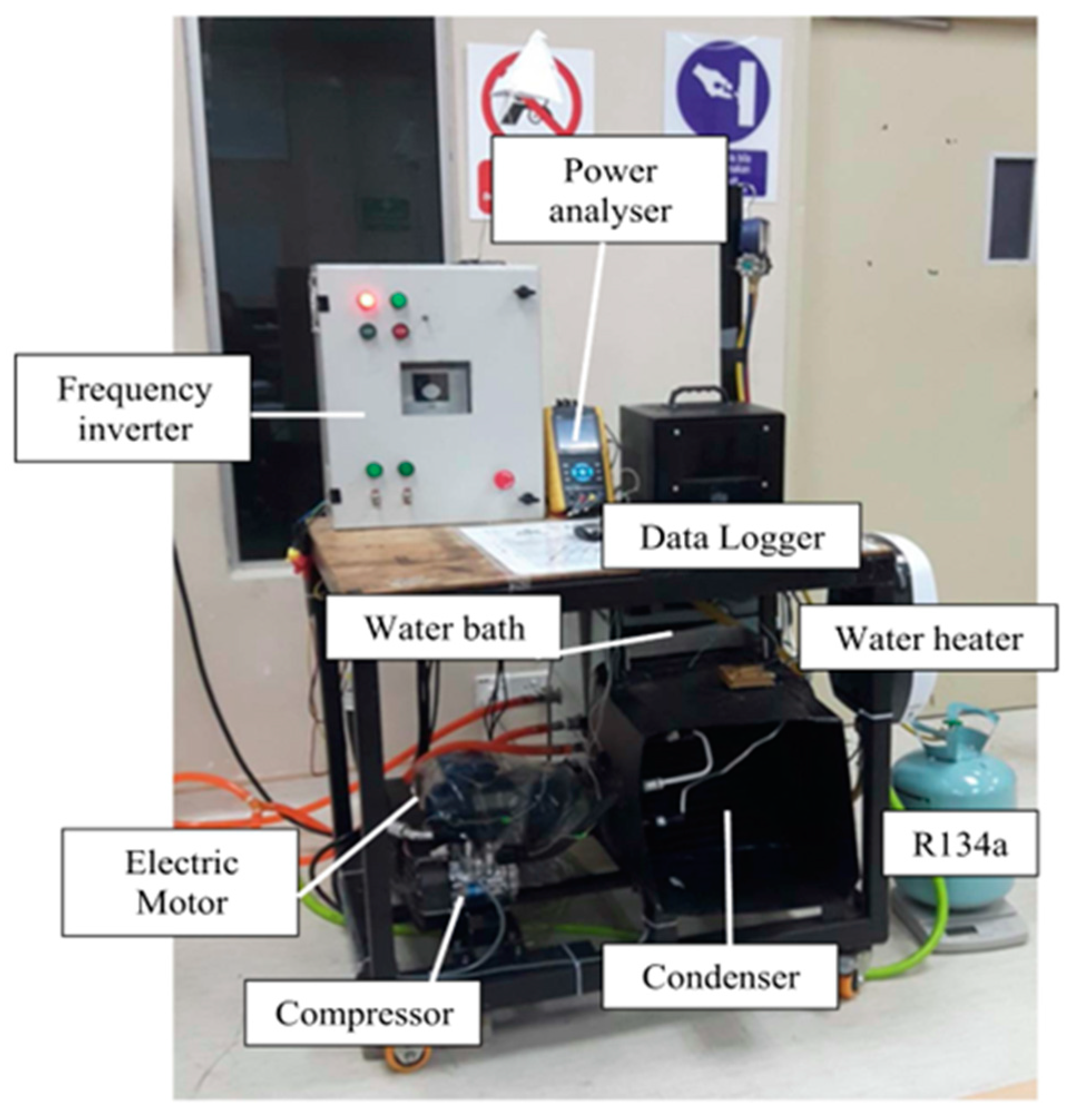
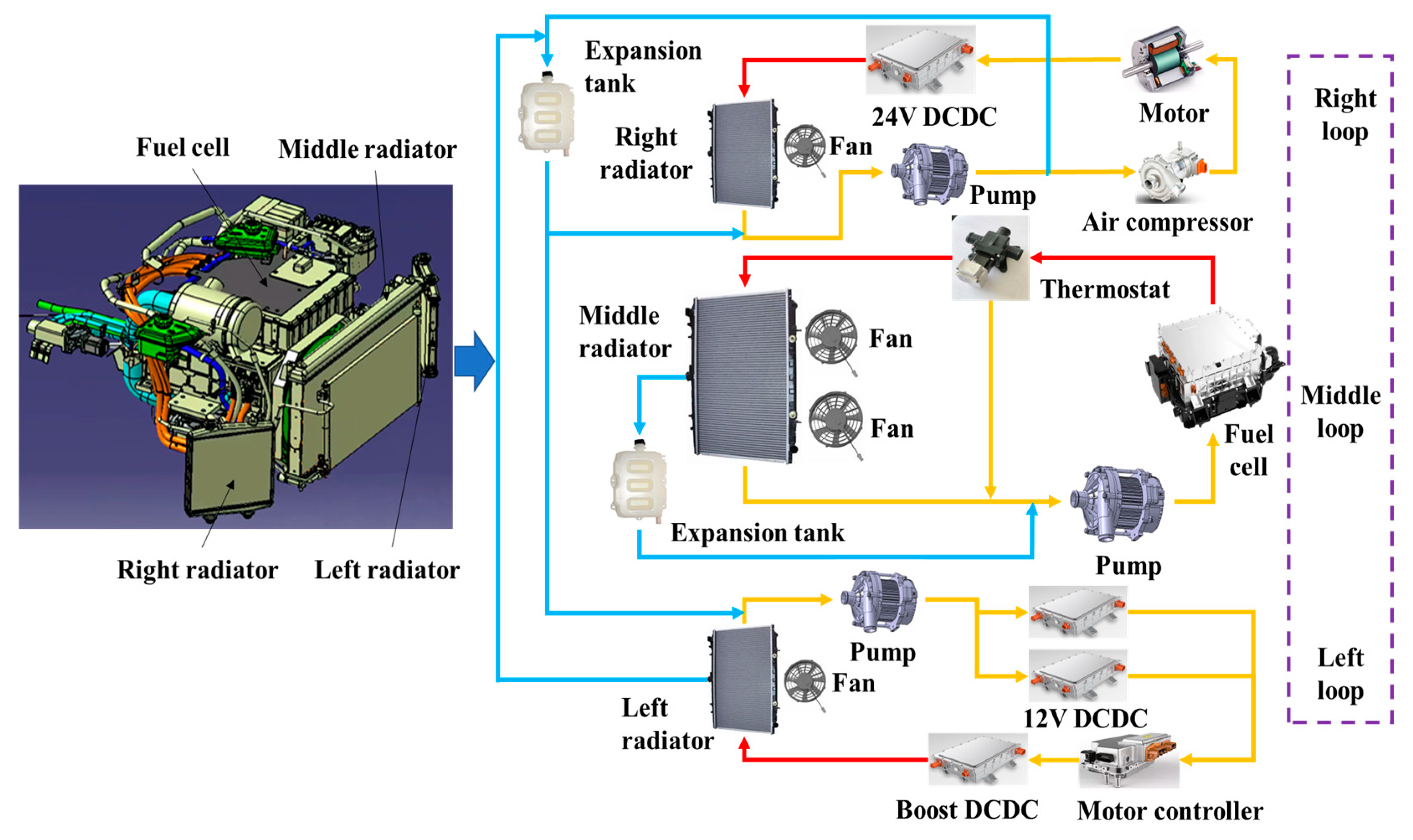
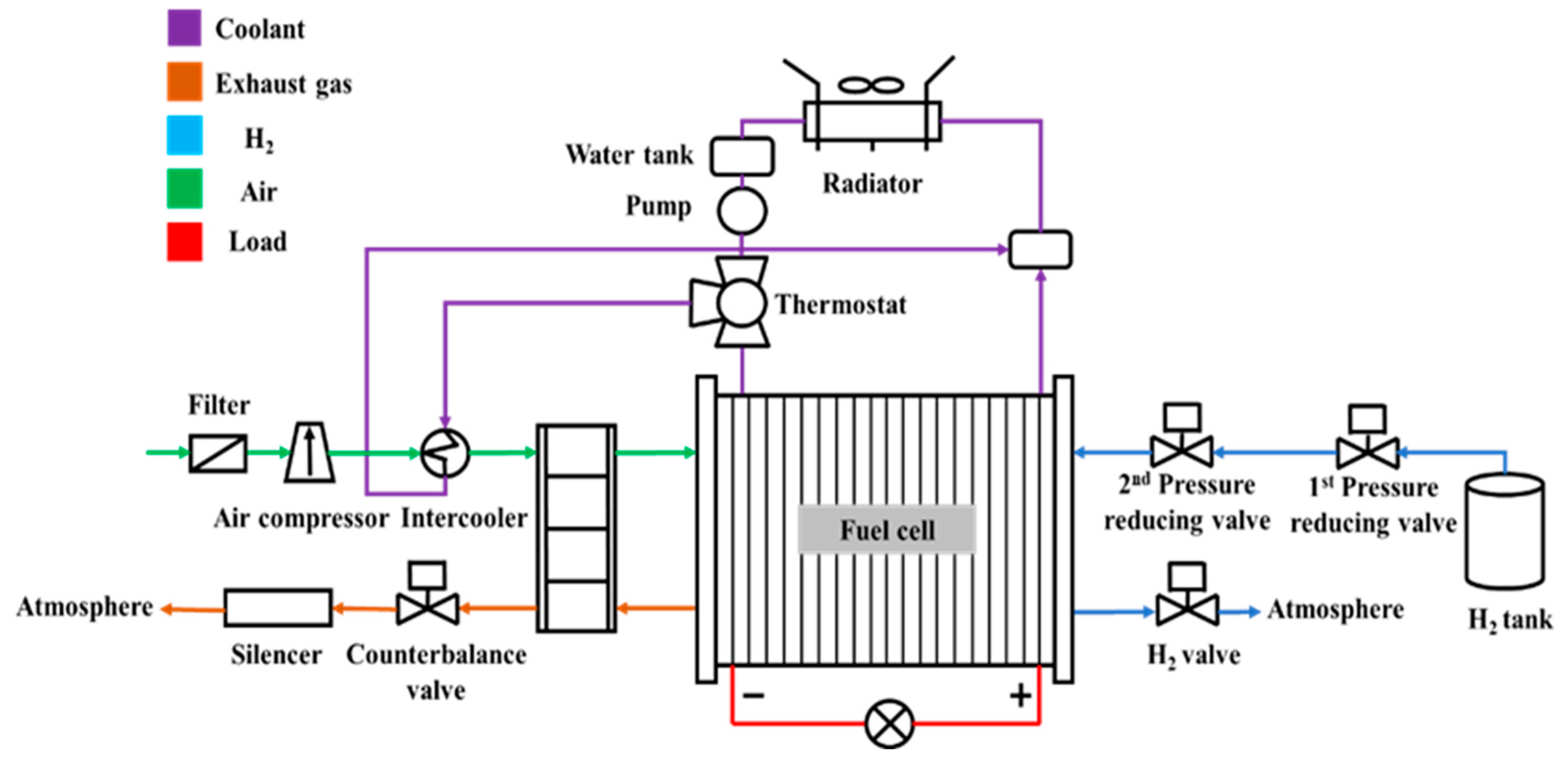

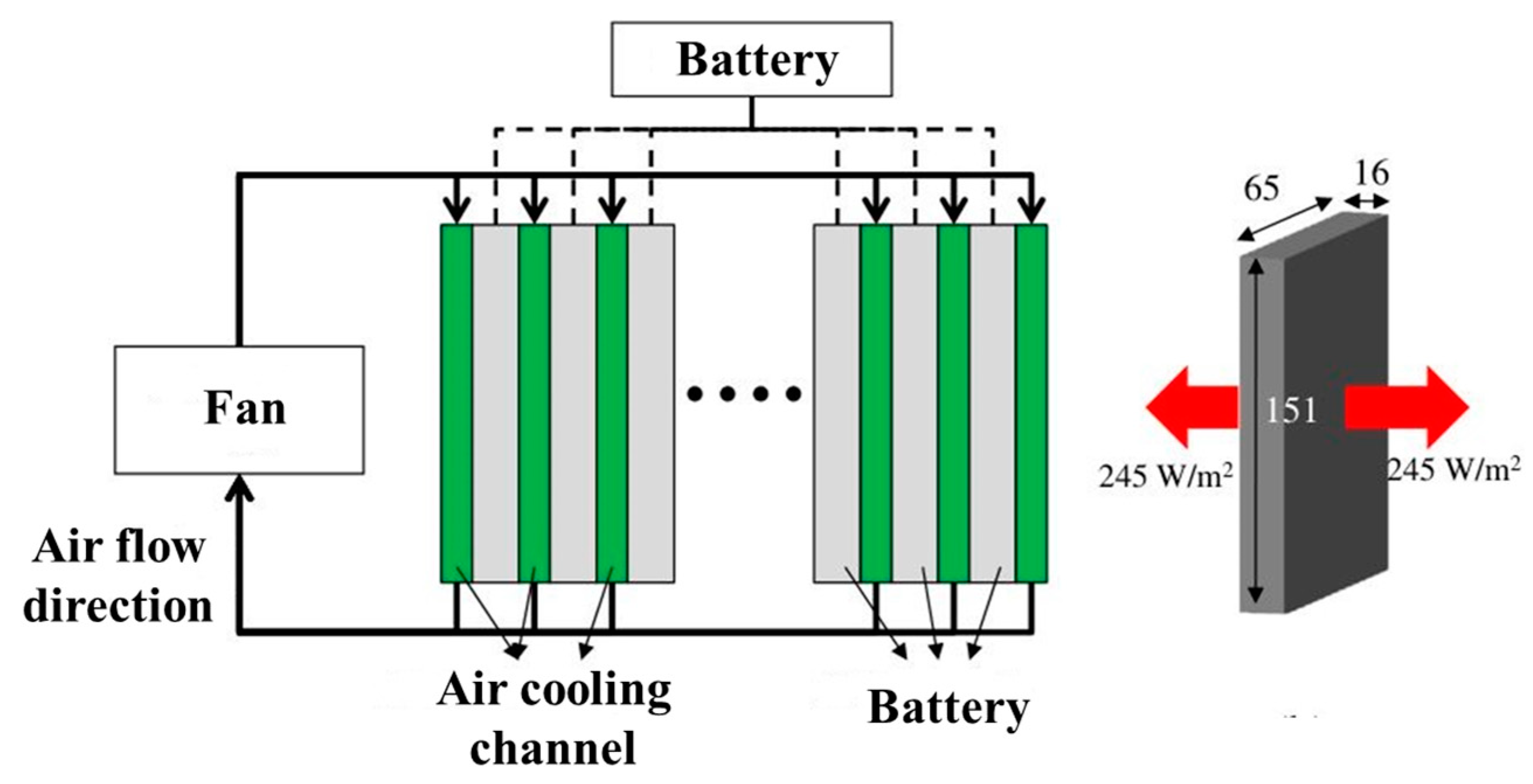
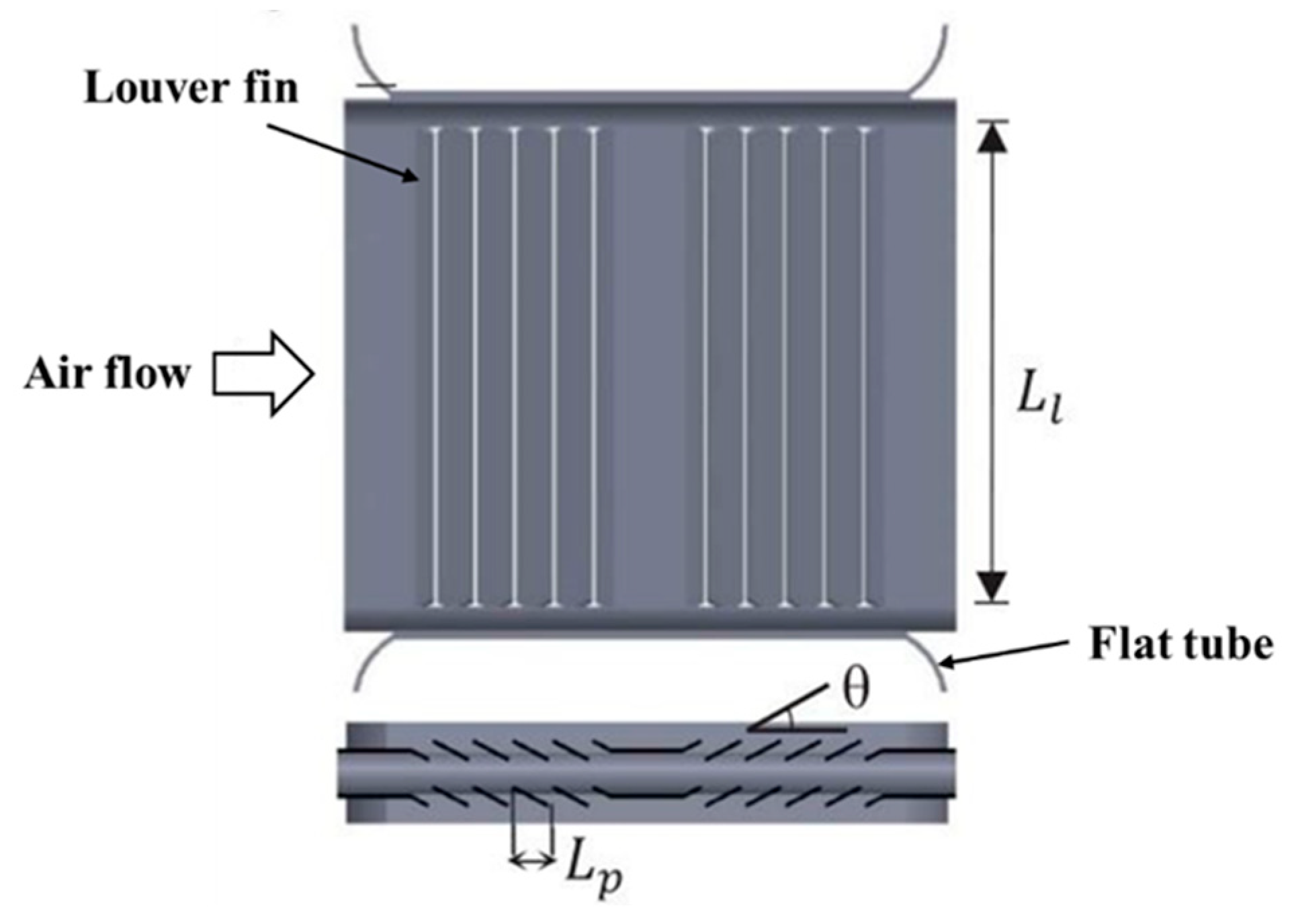


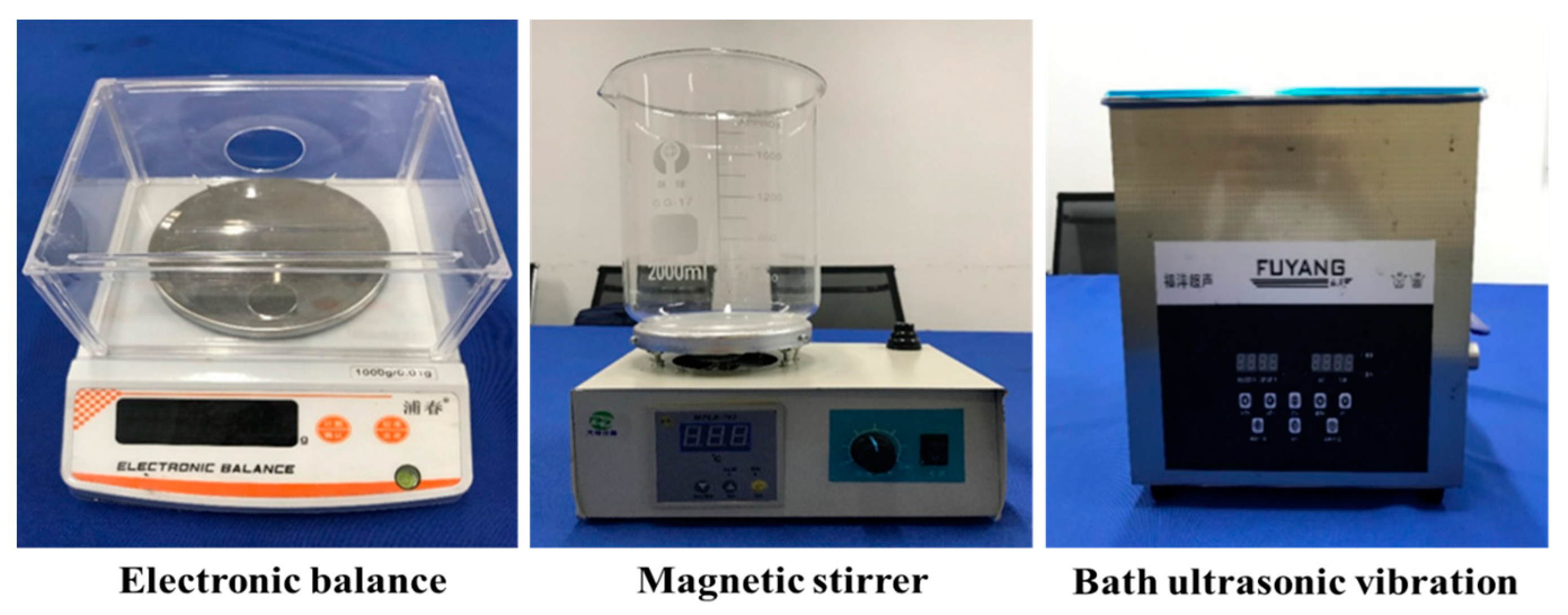
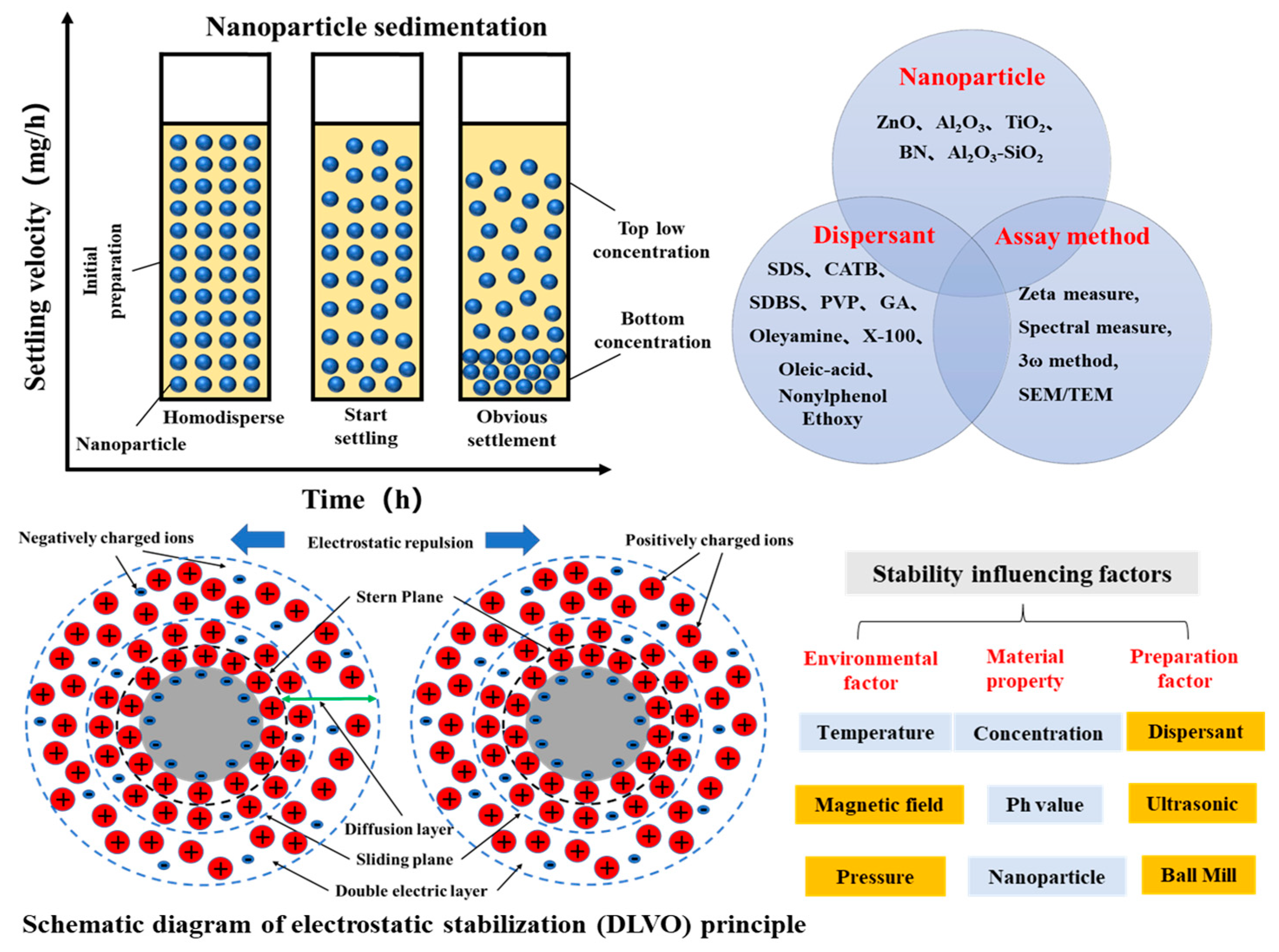
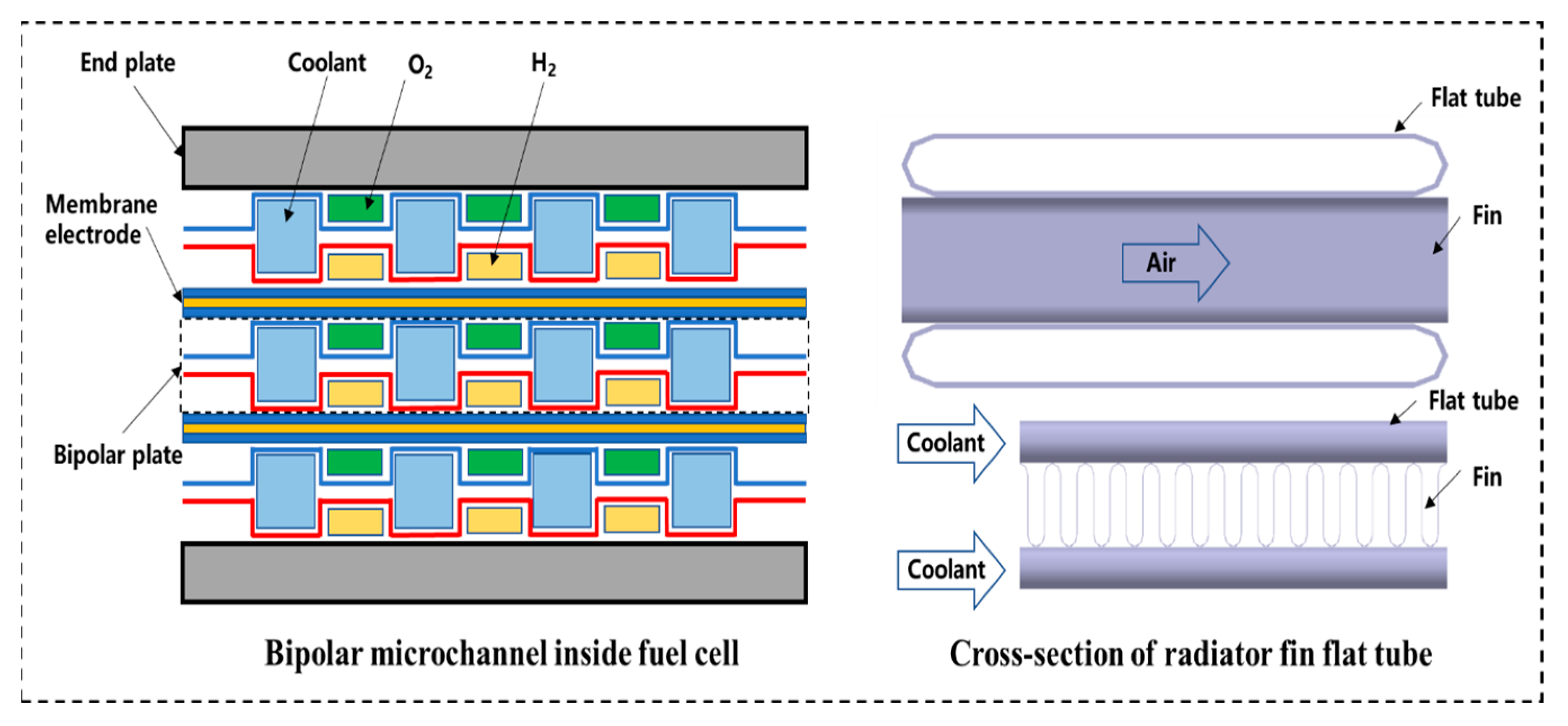
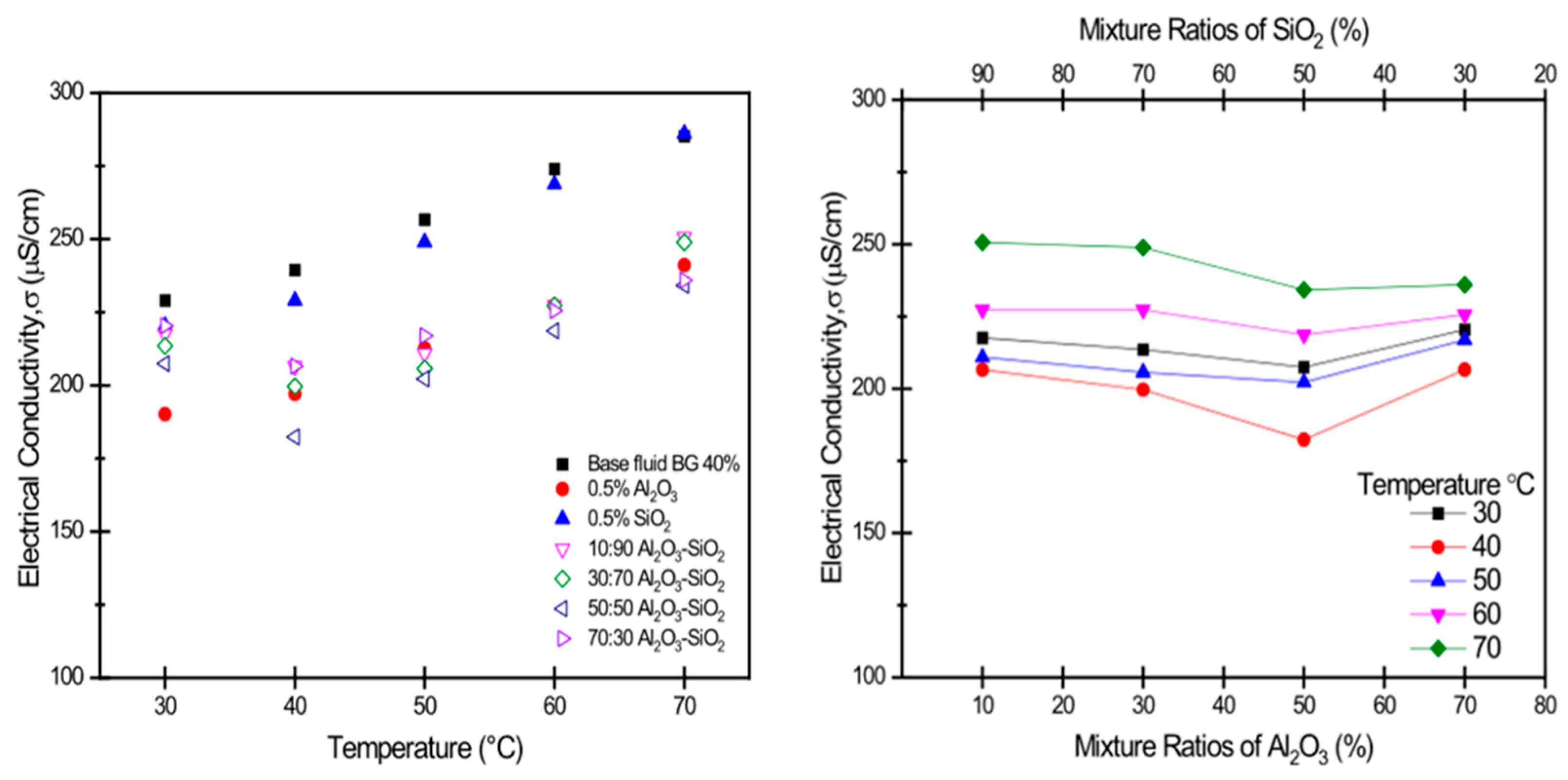
| Nanoparticle Type | Base Fluid | Concentration | Quantitative Analysis | Author/Ref. |
|---|---|---|---|---|
| GnP, CNC | WEG | 0.2% | OHTC increased by 46.72% | Yaw [53] |
| TiO2 | Water | 0.1%, 0.2%, 0.3% | Effectiveness of car radiator increased by 47% with 0.2% TiO2 | Ahmed [54] |
| TiO2 | Water | 0.025%, 0.05%, 0.1%, 0.2% | Heat transfer rate increased by 22.2% with 0.05% TiO2 | Elibol [55] |
| Al2O3, TiO2 | WEG | 0.3% | Thermal performance increased by 24.21% with 0.3% Al2O3 | Said [56] |
| TiO2 | Water | 0.1–4% | Nunf/Nubf≈1 with low concentration | Elibol [57] |
| Fly ash | WEG | 0.2–2% | Heat transfer rate increased by 7 kW | Palaniappan [58] |
| Al2O3 | Water | 0.1%, 0.2%, 0.4% | Heat transfer coefficient increased by 55% with 0.4% Al2O3 | Yasuri [59] |
| TiO2 | WEG | 0.1%, 0.3%, 0.5% | Heat transfer rate increased by 37% | Arora [60] |
| Al2O3 | Water | 0.1%, 0.5%, 1%, 1.5%, 2% | Heat transfer performance was the optimum at 1% | Ali [61] |
| CuO | Water | 0.2–0.5% | Pressure drops increased by 20% with 0.5% CuO | Sokhal [62] |
| Al2O3 | Water | 0.5–3% | Irreversibility increased by 0.3% at 15 LPM | Kumar [63] |
| Al2O3 | EG | 0.08%, 0.5%, 1% | Thermal performance increased up to 5% | Goudarzi [64] |
| Al2O3 | WEG | 0.3%, 0.6%, 0.9%, 1.2% | Heat transfer coefficient increased by 9% with Al2O3 | Sheikhzadeh [65] |
| TiO2, SiO2 | Water | 1%, 1.5%, 2% | Maximum Nusselt number increased by 11% and 22.5% | Hussein [66] |
| CuO | WEG | 0.05–0.8% | Heat transfer coefficient increased by 55% | Heris [67] |
| MWCNT, SiO2 | WEG | 0.1% | Cooling power increased by 40% | Kumar [68] |
| CuO | Water | 0–0.4% | Overall heat transfer coefficient increased by 8% | Naraki [69] |
| Al2O3 | WEG | 0.2%, 0.6%, 1% | Temperature effect was 41.72% | Seraj [70] |
| Zn, ZnO | Water | 0.15%, 0.25%, 0.5% | Radiator area reduced by 24% | Sonage [71] |
| CuO, CNT | Water | 1–3% | Heat transfer rate and efficiency increased by 19.35% and 7.2% | Sahoo [72] |
| Al2O3, CNT | Water | 1–3% | Irreversibility and entropy change increased by 42.45% and 27.27% | Sahoo [73] |
| Al2O3, CuO | WEG | 1–10%, 1–6% | Average heat transfer coefficient increased by 94% and 89% | Vajjha [74] |
| Graphene oxide | WEG | 0.1% | Maximum convective heat transfer increased by 69.7% | Shankara [75] |
| Al2O3 | W/WEG | 0–1% | Highest Nusselt number enhancement up to 40% | Peyghambarzadeh [76] |
| TiO2 | Water | 1%, 2%, 3%, 4% | Heat transfer efficiency increased by 20% | Hussein [77] |
| Al2O3, CuO | Water | 1%, 3%, 5%, 7% | Heat transfer coefficient increased by 45% and 38% | Elsebay [78] |
| Graphite | WEG | 0.6%, 1% | Overall heat transfer coefficient increased by 11.7% | Akash [79] |
| CuO | WEG | 0–2% | Air frontal area was reduced by 18.7% | Leong [80] |
| Al2O3 | WEG | 0.25%, 0.5%, 1% | Heat transfer performance increased by 37.2% | Karagoz [81] |
| Al2O3 | Water | 0.1–1% | Heat transfer rate increased by 45% | Peyghambarzadeh [82] |
| Graphene | WEG | 0.1–0.5% | Convective heat transfer coefficient increased by 51% | Selvam [83] |
| Fe3O4, CuO, Al2O3, SiO2 | WEG | 0.1%, 0.3%, 0.7%, 1% | Heat transfer efficiency increased by 3.2–45.9% | Yıldız [84] |
| Al2O3 | WEG | 0–1% | Highest thermal conductivity increased by 8.3% | Elias [85] |
| TiO2, SiO2 | Water | 1–2.5% | Effectiveness increased by 24% and 29.5% | Hussein [86] |
| Fe3O4-CQD, CuO-CQD | Water | 0.5% | Effectiveness increased by 12% and 25% | Mousavi [87] |
| SiO2 | Water | 0.04%, 0.08%, 0.12% | Heat transfer rate max. increased by 36.92% | Shah [88] |
| CuO, Fe2O3 | Water | 0.15%, 0.4%, 0.65% | Overall heat transfer coefficient max. increased by 9% | Peyghambarzadeh [89] |
| Fe3O4 | Water | 0–0.9% | Radiator heat transfer performance increased by 21% | Tafakhori [90] |
| Al2O3 | WMEG | 0.2–0.8% | Heat transfer rate increased by 30% | Subhedar [91] |
| MWCNT | WEG | 0.025%, 0.05%, 0.1% | Heat transfer rate and OHTC increased by 4.6% and 4.4% | Contreras [92] |
| CuO, TiO2, Al2O3 | Water | - | Knf was 0.72 with 5% CuO nanofluid | Khan [93] |
| Al2O3 | WEG | 0–1% | Nu was 237% higher than WEG | Delavari [94] |
| Al2O3(Ag, Cu, SiC, CuO) | WEG | 0–1% | Cooling flow rate reduced by 3.1% | Sahoo [95] |
| SiC | WEG | 0.5% | Thermal conductivity max. increased by 53.81% | Li [96] |
| MWCNTs | SG | 0.2%, 0.4%, 0.6% | Nusselt number max. increased by 18.39% | Sivalingam [97] |
| MWCNTs | WEG | 0.1%, 0.25%, 0.5% | Average heat transfer coefficient max. increased by 196.3% | Mhamed [98] |
| ZnO | WEG | 0.01–0.04% | Heat transfer rate max. increased by 36% | Khan [99] |
| Cooling Method | Output Power |
|---|---|
| Cathode air cooling | <100 W |
| Separate airflow cooling | 200–2000 W |
| Phase change | 1000 W |
| Liquid cooling | >10 kW |
| Component | Heat-Dissipation Method | Improvement Method |
|---|---|---|
| Fuel cell | Liquid cooling | Structure |
| Control strategy | ||
| Coolant | ||
| Power battery | Air/liquid/phase change/heat pipe cooling | Structure |
| Coolant | ||
| Motor and controller | Natural/air/liquid/oil cooling | Structure |
| Coolant | ||
| Air compressor | Liquid-cooled/air-cooled | Structure |
| Coolant | ||
| DC/DC converter | Liquid cooling | Structure |
| Coolant |
| Type | Density kg/m3 | Specific Heat J/(kg·K) | Thermal Conductivity W/(m·K) |
|---|---|---|---|
| ZnO | 5610 | 544 | 25 |
| Al2O3 | 4000 | 765 | 36 |
| TiO2 | 4260 | 710 | 8.2 |
| BN | 2270 | 900 | 260 |
| Type | Author | Method | Result |
|---|---|---|---|
| ZnO | Islam | Experiment | Radiator area reduced by 27% |
| Al2O3 | Zakaria | Experiment | Heat dissipation increased by 13.87% |
| TiO2 | Islam | Experiment/Theory | Thermal conductivity increased by 10% |
| Al2O3-SiO2 | Johari | Experiment | Thermal conductivity increased by 21% |
| Al2O3-SiO2 | Khalid | Experiment | 10:90 was the most feasible ratio |
Disclaimer/Publisher’s Note: The statements, opinions and data contained in all publications are solely those of the individual author(s) and contributor(s) and not of MDPI and/or the editor(s). MDPI and/or the editor(s) disclaim responsibility for any injury to people or property resulting from any ideas, methods, instructions or products referred to in the content. |
© 2023 by the authors. Licensee MDPI, Basel, Switzerland. This article is an open access article distributed under the terms and conditions of the Creative Commons Attribution (CC BY) license (https://creativecommons.org/licenses/by/4.0/).
Share and Cite
Tao, Q.; Zhong, F.; Deng, Y.; Wang, Y.; Su, C. A Review of Nanofluids as Coolants for Thermal Management Systems in Fuel Cell Vehicles. Nanomaterials 2023, 13, 2861. https://doi.org/10.3390/nano13212861
Tao Q, Zhong F, Deng Y, Wang Y, Su C. A Review of Nanofluids as Coolants for Thermal Management Systems in Fuel Cell Vehicles. Nanomaterials. 2023; 13(21):2861. https://doi.org/10.3390/nano13212861
Chicago/Turabian StyleTao, Qi, Fei Zhong, Yadong Deng, Yiping Wang, and Chuqi Su. 2023. "A Review of Nanofluids as Coolants for Thermal Management Systems in Fuel Cell Vehicles" Nanomaterials 13, no. 21: 2861. https://doi.org/10.3390/nano13212861
APA StyleTao, Q., Zhong, F., Deng, Y., Wang, Y., & Su, C. (2023). A Review of Nanofluids as Coolants for Thermal Management Systems in Fuel Cell Vehicles. Nanomaterials, 13(21), 2861. https://doi.org/10.3390/nano13212861







